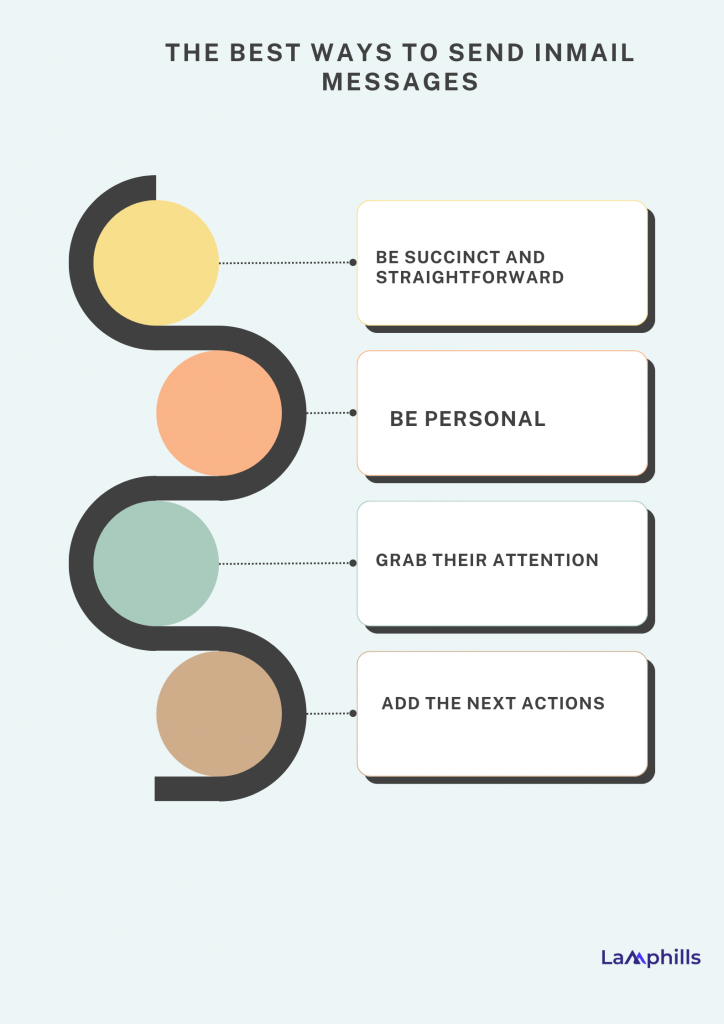LinkedIn is a wealth of professional contacts—provided you can find who you want. If you’re a LinkedIn user, you’ve probably heard of LinkedIn messages used to communicate with individuals you know. Talking to your contacts is simple, but what happens when you need to speak with someone outside of your circle?
Fortunately, I’ve got you covered in this article. InMail makes the greater LinkedIn world accessible.
Key Takeaways
- Tailored messages that include specific information from a candidate’s profile or background can boost response rates by up to 40%.
- Sending InMails from Sunday to Thursday produces better results, with Friday and Saturday being the least effective days for outreach.
- InMails with fewer than 400 characters receive 22% more responses than the average, whereas messages with more than 800 characters receive lower rates.
- Mentioning a previous job or a mutual connection can boost response rates by 27 percent.
- A strong, engaging subject line is essential for getting your message opened and read.
- To pique the recipient’s interest in your opportunity, clearly communicate what they will gain from it.
- LinkedIn’s AI-Assisted Messages feature can help you create personalized outreach messages in less time while maintaining a personal touch.
What is LinkedIn InMail?
InMail is a paid LinkedIn tool that allows you to message other users who aren’t in your network. You’ll receive between three and thirty InMail credits monthly, depending on your plan.
With InMail, you can contact recruiters and hiring managers on LinkedIn.
What InMail Costs
InMail costs will depend on the premium subscription you opt for and how many credits you need in a month.
At the conclusion of each month, unused credits will add up to your balance and are good for a maximum of 120 days.
How to Effectively Send InMail on LinkedIn
Here are a few LinkedIn InMail best practices to help you enhance your cold outreach and boost your response rate when hiring your next superstar.
#1. Share with the Applicant what makes them Unique
Be sure to include some flattery in your messages while you’re thinking about how to make them more unique. People are more inclined to assist others—in this case, replying to your message—when they believe that their abilities and efforts are valued.
Tell the candidate what makes them unique, then. You must have been drawn to something since you took the time to look them up. To demonstrate your sincerity, be sure to include details. Saying “your background is impressive” is not enough; elaborate on what makes it impressive and why.
Even better, clearly distinguish between the candidate’s accomplishments and why you are considering them. For example, you may highlight a unique ability that your business lacks or mention that the prospect was referred to you by someone with insider knowledge.
According to data conducted by LinkedIn, more than 50% of candidates anticipate that their recruiters will include specifics regarding their accomplishments and why they are a good fit for the company. Therefore, don’t expect a positive reaction if you don’t take this action.
#2. Determine Which Candidates are Most Likely to Reply
Initially, certain prospects are more likely than others to reply to your emails:
Following your business on LinkedIn increases response rates by 81%.
If a candidate already knows someone at your organization, they are 46% more likely to accept your email.
“Open to Work” candidates have a roughly 35% higher response rate than other candidates.
Filter your LinkedIn recruiter search results to prioritize contacting these candidates so you can get off to a good start.
The recruiter’s new candidate profile card will also draw attention to applicants who are very or somewhat likely to be interested in your position. You can prioritize candidates who are most likely to reply by using the Likelihood of Interest feature, which leverages artificial intelligence to compile and decipher interest signals like “Open to work” and InMail acceptance.
When prospects reply, you’ll receive an InMail credit that lets you reach a wider audience and improve your chances of spotting your next great recruit.
#3. Write a Compelling Subject Line
Your subject line is your first chance to catch a candidate’s eye, and you can increase or decrease your chances of receiving a response.
A candidate who is content with their current employer is unlikely to jump at the chance to apply for a job when they see a subject line like “Career opportunity” or “Trying to fill X position.” Furthermore, there is less likelihood that an in-demand prospect who might be getting dozens of emails will open your bland-looking message.
No matter how fantastic the opportunity is, it won’t matter if the applicant never looks into it further. Because of this, crafting a strong subject line is the most crucial aspect of sending a message.
Write succinct subject lines for your emails. It is best not to reveal too much information immediately because a little mystery will entice the prospect to read the message and learn more. Additionally, try to establish a personal connection whenever you can by mentioning a common hobby or former employment.
#4. Talk about “What’s in it for me”
Your prospects have standards for assessing a new position, just as you do for a new hire. Give them some information about the benefits of your offer to pique their curiosity.
Even though it could be challenging to determine what each prospect would find most appealing, you can still advance the conversation with a few well-informed assumptions.
#5. Emphasize Shared Ties
Your odds of receiving a response from a candidate increase by 27% if you mention a shared previous job in your initial correspondence. And when you bring up a shared connection, the same thing occurs.
If you consistently hire people from the same area and industry, you probably have a mutual link. Before anything else, see if the candidate is connected to any employees of your organization. Bring up that employee’s name to quickly convey to the candidate the value of your business—after all, if their friend is happy there, they most likely will be, too.
Should that tactic prove ineffective, find out if you have any ties to the individuals who have recommended or backed the candidate’s abilities. Mentioning this type of relationship, such as stating that the applicant’s previous employer gave them high marks for their coding prowess, can also be a genuine kind of flattery, which increases its impact.
#6. Customize Your Communication
If your message appears to have been copied and pasted, a candidate is unlikely to reply, let alone read to the end. This is true even if your subject line is excellent.
Relevant, tailored communications have a higher chance of getting candidates’ responses. According to LinkedIn research, Personalized InMails have the potential to raise acceptance rates by 40%.
Mention a particular blog post or article that the candidate has authored and distributed via social media. Make reference to anything from their past, such as a business they used to work for or a project they spearheaded. It doesn’t have to be anything revolutionary; merely mentioning an odd pastime they have listed on their profile would suffice.
Even with that degree of effort and time, you might not achieve the desired level of customization. With just one click, you can create distinctive, completely personalized outreach messages using LinkedIn Recruiter’s new AI-Assisted Messages feature. The AI model generates a personalized message for each individual based on data from their profile, the job description, and the recruiter’s business. This message may be adjusted and changed before being sent.
#7. Offer the Next Steps
Adding a simple next step or call to action puts the ball in the candidate’s court, urging them to pick it up and return it to you. Share your calendar availability to plan a call, or ask the candidate to suggest a couple times that would work for you.
Be respectful and understand that they most likely have other obligations, especially if they are actively employed elsewhere and may have childcare or elderly care responsibilities at home.
Checklist: How to Craft an Effective LinkedIn InMail.pdf
#8. Keep Your Emails Short
Less is more, as the saying goes. That is certainly true in the case of cold outreach.
LinkedIn research shows that InMails under 400 characters receive 22% more responses than the average response rate for all InMails. On the other hand, messages longer than 800 characters receive lower-than-average response rates—so keep your InMails brief and sweet.
Write just enough to convey vital information and inspire them to respond to learn more. Even if they are not actively seeking a new career, a modest sample can pique their interest and make them want to learn more.
#9. Message the Candidates
Sending InMails at the proper moment lets you get your message in front of your candidates when they are most responsive and likely to respond.
The hardest days are Friday and Saturday. InMails submitted on Saturday received 8% fewer responses, while those sent on Friday received 4% fewer responses than the overall average of InMails.
Rather than sending InMails late in the week, schedule them for Sunday through Thursday, when you’ll have a better chance of engaging. If you’re recruiting for an industry or function with poor InMail response rates, try sending messages on Sundays, when only 2% of InMails are sent. That may assist your message to stand out to the most sought-after candidates.
#10. Test Your Messaging
When was the last time you updated your candidate outreach templates? If it’s been a while, consider using a new LinkedIn InMail template to see how it affects response rates.
To improve response rates, consider mentioning flexible work policies in paid job postings on LinkedIn. Compared to two years ago, these posts received 175% more views and 139% more applications. Regularly tweaking your message can help promote your opportunities and optimize response rates.
The Best Ways to Send InMail Messages
Because you already know each other, messaging connections is simple, and receiving a response is equally simple. With InMail, it’s not the same. You must be more deliberate in your messages because you have a limited number of InMail credits in order to make the most of your monthly message budget.

Use these pointers to send effective in-mails that maintain high response rates.
#1. Be Succinct and Straightforward
InMail is only meant to spark discussion. Even though it could be tempting to provide every detail, it is wiser to convey an uncomplicated, brief message. LinkedIn confirmed this, which found that shorter InMail messages (those with fewer than 800 characters) obtain above-average response rates, whereas lengthier messages receive below-average answers.
Since the person you’re contacting is presumably busy and has a lot of messages to read, it will be easier for them to read and reply if your note is succinct. It should be enough to write a few sentences that include the important details, such as why you’re contacting them and what you want them to do.
#2. Be Personal
Although they save time, templates don’t work as well with LinkedIn InMail. Even if several templates are available with a fast online search, these formulas lack personality and may even appear unsettling. The same LinkedIn study confirms this, showing that customized InMail messages have a 15% higher response rate than bulk ones.
Better outcomes are obtained from messages that show interest in the receiver and are customized to fit their personality. Try to write as many original InMails as you can. Alternatively, if you must use templates, make sure to personalize each message before sending it.
#3. Grab Their Attention
Add something that might catch the recipient’s attention, such as a recent post, a fascinating passage from their profile, or a similarity between you. It pays to do a little research. Their content and areas of interest might serve as great sources of information for creating a visually appealing InMail message.
LinkedIn InMail Template for Cold Outreach.pdf
#4. Add the Next Actions
Your chances of getting a response increase if you provide explicit instructions on what to do after reading your message. Just ask for small, quick things while making requests. This could take the form of making plans for future communication and requesting guidance or a recommendation.
To avoid frightening the recipient away, be cautious while making requests in your initial correspondence.
What is an InMail on LinkedIn?
LinkedIn’s InMail is a premium tool that allows users to send direct messages to LinkedIn members with whom they are not linked. InMails, like emails, can have a subject line and more characters than a standard LinkedIn message or connection request.
What is the difference between LinkedIn InMail and DM?
The distinction between InMails and messages is that InMails can be sent to anybody, whereas messages are limited to your first-degree relationships.
Is it better to InMail or connect on LinkedIn?
Connection requests are a natural method to connect with others on LinkedIn. It’s similar to how you might communicate with a friend or colleague. Sending a connection request makes you look less sales than sending an InMail.
When should you send InMail on LinkedIn?
According to LinkedIn, there is no optimal time to send an InMail because prospects answer whenever convenient. However, some believe that InMails received during office hours on weekdays are more likely to receive a response. Here are some suggestions for when to send InMails on LinkedIn.
Monday is widely regarded as the best day to send an InMail, whilst Saturday is the worst. InMails submitted on Friday received 4% fewer responses than the norm, and InMails sent on Saturday received 8% less.
Conclusion
Now that you’ve learned the basics of sending InMails, it’s time to implement them into your LinkedIn approach. While you must pay for a subscription, this provides you with a highly useful tool in your outreach armory. You can contact prospective employees, B2B decision-makers, or perhaps your next employer without establishing a connection beforehand.
Related Articles
- How Much Is LinkedIn Premium? A Breakdown of LinkedIn Premium Plans
- Is LinkedIn Premium Worth It? Here’s What You Need to Know
- How to Find Someone’s Email on LinkedIn: 4 Ways to Find Someone’s Email on LinkedIn in 2024
- Top Paid Media Tips to Explode Your Business Growth






